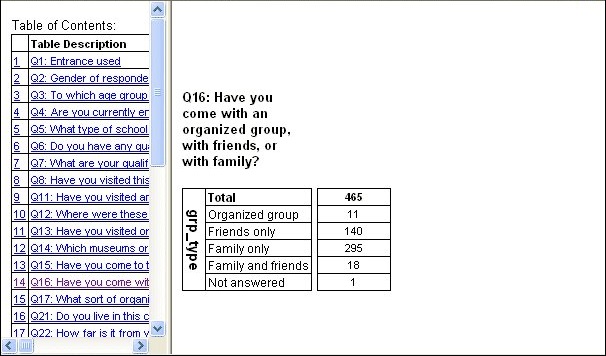A complete example
This example does the following:
▪Creates top line tables for all of the simple categorical variables in the UNICOM Intelligence Interviewer - Paper routing. This means that the tables are created in the same order as they appear on the questionnaire.
▪Sets the user context to Question in both the table document and the MDM document.
▪Changes the text on the autobase element to read "Total" instead of "Base".
▪Sets up the table description to show the variable short name (which stores the question number) as well as the question text.
▪Uses the UseVariableLabels export property to export the variable names rather than the variable labels.
' Set the user context in the table document to Question
TableDoc.Context = "Question"
' Set the current user context in the MDM Document to Question
TableDoc.DataSet.MDMDocument.Contexts.Current = "Question"
' Set the Analysis context as an alternative for Question.
' This means that if texts are missing in the Question context,
' they will automatically be taken from the Analysis context.
TableDoc.DataSet.MDMDocument.Contexts.Item["Question"].Alternatives.Add("Analysis")
Dim MyCounter, i, MyRoutingItem, MyField, MyTableName, MyTableSpec, MyTableDescription
' Set the counter to zero
MyCounter = 0
' Loop through the Paper routing items
' and create a top-line table for all of
' the simple categorical variable instances in the routing
' that have a short name defined
For i = 0 To TableDoc.DataSet.MDMDocument.RoutingItems.Count - 1
Set MyRoutingItem = TableDoc.DataSet.MDMDocument.RoutingItems.Item[i]
Set MyField = TableDoc.DataSet.MDMDocument.Fields[MyRoutingItem.Name]
' Test that it is a simple variable and that the short name label isn't blank
If MyField.ObjectTypeValue = 0 _
And Not MyField.Labels["ShortName"].Text["Question"].IsEmpty() Then
' Check that it's a categorical variable
If MyField.DataType = mr.Categorical Then
MyCounter = MyCounter + 1
MyTableName = "Table" + CText(MyCounter)
MyTableSpec = MyField.FullName
MyTableDescription = MyField.Labels["ShortName"].Text
MyTableDescription = MyTableDescription + ": " + _
MyField.Labels["Label"].Text
TableDoc.Tables.AddNew(MyTableName, MyTableSpec, MyTableDescription)
' Set the label on the Autobase element to read "Total" instead of "Base"
TableDoc.Tables[MyTableName].Side.SubAxes[MyTableSpec].Elements.Base.Label = "Total"
End If
End If
Next
' Populate the tables
TableDoc.Populate()
' Export the tables
With TableDoc.Exports.mrHtmlExport
.Properties["Interactive"] = True
.Properties["LaunchApplication"] = True
.Properties["DisplayOption"] = "Table Only"
' Export variable names rather than labels
.Properties["UseVariableLabels"] = False
.Properties["LayoutStyle"] = "Frame Table of Contents"
.Export(" [INSTALL_FOLDER]\IBM\SPSS\DataCollection\7\DDL\Output\WorkingWithLabels.htm")
End With
HTML file output by WorkingWithLabels.mrs script, showing table of contents with table 14 selected
See also

